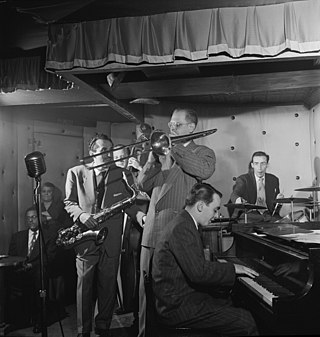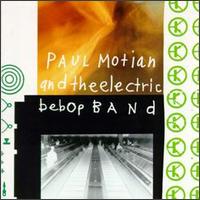Related Research Articles

Tadley Ewing Peake Dameron was an American jazz composer, arranger, and pianist.

Theodore "Fats" Navarro was an American jazz trumpet player. He was a pioneer of the bebop style of jazz improvisation in the 1940s. He had a strong stylistic influence on many other players, including Clifford Brown.

Dillon "Curley" Russell was an American jazz musician, who played bass on many bebop recordings.

Jazz at Massey Hall is a live jazz album recorded on 15 May 1953 at Massey Hall in Toronto, Canada. Credited to "the Quintet", the group was composed of five leading 'modern' players of the day: Dizzy Gillespie, Charlie Parker, Bud Powell, Charles Mingus, and Max Roach. It was the only time that the five musicians recorded together as a unit, and it was the last recorded meeting of Parker and Gillespie.
The Royal Roost was a jazz club located at 1580 Broadway in the Theater District of Manhattan in New York City.

James Moody was an American jazz saxophone and flute player and very occasional vocalist, playing predominantly in the bebop and hard bop styles.
"Salt Peanuts" is a bebop tune composed by Dizzy Gillespie in 1941, co-written by drummer Kenny Clarke. The song was copyrighted on October 13, 1941 and credited to both musicians. It has also been erroneously cited as Charlie Parker's. Parker himself publicly credited Gillespie as the composer on May 15, 1953, as may be heard on the Jazz at Massey Hall live recording. The original lyrics have no exophoric meaning. Instead, they are a skat/bebop vocal which matches the octave note interval played predominantly throughout the song. The Pointer Sisters subsequently included vocalese lyrics for their rendition of Salt Peanuts as recorded on their That's a Plenty album.

Babs Gonzales, born Lee Brown, was an American bebop vocalist, poet, and self-published author. His books portrayed the jazz world that many black musicians struggled in, portraying disk jockeys, club owners, liquor, drugs, and racism. "There are jazz people whose influence can be described as minor," wrote Val Wilmer, "yet who are well-known to musicians and listeners alike ... You'd have to be hard-pressed to ignore the wealth of legend that surrounds Babs Gonzales." Jazz writer Jack Cooke explained that Gonzales "assumed the role of spokesman for the whole hipster world... [becoming] something more than just a good and original jazz entertainer: the incarnation of a whole social group."
"Con Alma" is a jazz standard written by Dizzy Gillespie, appearing on his 1954 album Afro. The tune incorporates aspects of bebop jazz and Latin rhythm, and is known for its frequent changes in key centers, while still maintaining a singable melody.
Nelson Boyd was an American bebop jazz bassist.
"Groovin' High" is an influential 1945 song by jazz composer and trumpeter Dizzy Gillespie. The song was a bebop mainstay that became a jazz standard, one of Gillespie's best known hits, and according to Bebop: The Music and Its Players author Thomas Owens, "the first famous bebop recording". The song is a complex musical arrangement based on the chord structure of the 1920 standard originally recorded by Paul Whiteman, "Whispering", with lyrics by John Schonberger and Richard Coburn (né Frank Reginald DeLong; 1886–1952) and music by Vincent Rose. The biography Dizzy characterizes the song as "a pleasant medium-tempo tune" that "demonstrates...[Gillespie's] skill in fashioning interesting textures using only six instruments".

Groovin' High is a 1955 compilation album of studio sessions by jazz composer and trumpeter Dizzy Gillespie. The Rough Guide to Jazz describes the album as "some of the key bebop small-group and big band recordings."

Something Old, Something New is a studio album by Dizzy Gillespie, recorded and released in 1963.

Paul Motian and the Electric Bebop Band is an album of bebop jazz standards by American drummer Paul Motian originally released on the German JMT label. It was the first release by the Electric Bebop Band, which featured the veteran drummer working mainly with younger musicians and which subsequently became one of Motian's primary groups until the end of his life.
"Our Delight" is a 1946 jazz standard, composed by Tadd Dameron. It is considered one of his best compositions along with "Good Bait", "Hot House", "If You Could See Me Now", and "Lady Bird". It has an AABA construction. A moderately fast bebop song, it featured the trumpeter Fats Navarro, who is said to "exhibit mastery of the difficult chord progression". One author said, "'Our Delight' is a genuine song, a bubbly, jaggedly ascending theme that sticks in one's mind, enriched by harmonic interplay between a flaming trumpet section led by Dizzy, creamy moaning reeds and crooning trombones. The written accompaniments to the solos-in particular the leader's two statements-are full of inventiveness, creating call-and-response patterns and counter-melodies. What is boppish here is the off-center, syncopated melody, as well as the shifting, internal voicings of the chords, especially at the very end. These voicings, along with a love of tuneful melodies that one walks out of a jazz club humming, were Tadd's main legacy to such composers and arrangers as Benny Golson, Gigi Gryce, and Jimmy Heath." Rolling Stone describes it as a "bop gem". The first publication is by Dizzy Gillespie in August 1946. In total there are more than 120 covers of Our Delight. Bill Evans recorded his version of it for his debut album New Jazz Conceptions in 1956.

The Bop Session is an album by jazz legends Dizzy Gillespie, Sonny Stitt, John Lewis, Hank Jones, Percy Heath and Max Roach recorded in 1975 and released on the Swedish Sonet label.
"Good Bait" is a jazz composition written by American jazz piano player and composer Tadd Dameron and by band leader Count Basie. It was introduced in 1944 and was popular in the 1940s and 1950s.

The Complete RCA Victor Recordings is a 1995 compilation 2-CD set of sessions led by Jazz trumpeter and composer Dizzy Gillespie recorded for the RCA Victor label between 1937 and 1949.

BeBopBeBopBeBopBeBop is an album of bebop standards by pianist Paul Bley recorded in Denmark in 1989 and released on the SteepleChase label.

Anthony Braxton's Charlie Parker Project 1993 is an album featuring live and studio performances of compositions associated with Charlie Parker arranged and performed by saxophonist Anthony Braxton which was recorded in Switzerland and Germany in 1993 and released on the HatART label as a double CD in 1995.
References
- ↑ Dizzy Gillespie and Charlie Parker playing "Hot House" in 1952 on television, YouTube Archived November 29, 2011, at the Wayback Machine
- ↑ under Stan Getz' names, the 1947 LP Groovin High included "Hot House" as one of the tracks showing an early appreciation for the tune as a jazz standard
- ↑ Hot House is on long list of over 500 recordings [ permanent dead link ], Allmusic.com
- ↑ "Chaka Khan overview". Allmusic.com .
- ↑ Nat Hentoff (1988). East To Wes (booklet, page 4). Emily Remler. Concord Records. CCD-4356.
- ↑ "Private Concert overview". Allmusic.com .
- ↑ Print Music for Hot House
- ↑ All About Jazz, CD review by Jack Bowers Archived 2004-11-06 at the Wayback Machine
- ↑ [http://www.allmusic.com/album/up-your-brass-r619666 Up Your Brass. Allmusic.com
- ↑ James Moody: Moody 4B (2010) All About Jazz review, By DAN BILAWSKY, August 18, 2010
- ↑ San Diego's James Moody and Switchfoot win Grammys, Sign-On San Diego, February 13, 2011